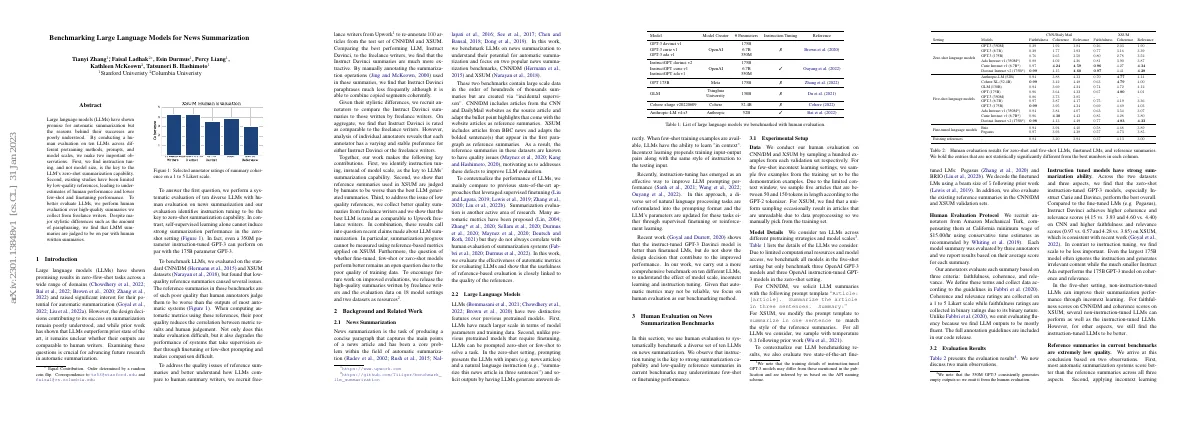Link to paper
The full paper is available here.
You can also find the paper on PapersWithCode here.
Abstract
- LLMs have shown promise for automatic summarization
- Instruction tuning is the key to LLM’s zero-shot summarization capability
- Existing studies have been limited by low-quality references
- Human evaluation over high-quality summaries from freelance writers shows LLM summaries are on par with human written summaries
Paper Content
Introduction
- Large language models (LLMs) have shown promising results in zero-/few-shot tasks across a wide range of domains
- LLMs have potential for automatic summarization
- Design decisions contributing to success on summarization remain poorly understood
- Evaluation of 10 diverse LLMs with human evaluation on news summarization
- Instruction tuning is key to zero-shot summarization capability
- Self-supervised learning alone cannot induce strong summarization performance in the zero-shot setting
- Poor quality reference summaries reduce correlation between metric results and human judgement
- Recruit freelance writers to re-annotate 100 articles from the test set of CNN/DM and XSUM
- Best performing LLM is rated as comparable to freelance writers
- Instruction tuning, not model scale, is key to LLMs’ summarization capability
- Poor quality of training data makes comparison difficult
News summarization
- News summarization is the task of producing a concise paragraph that captures the main points of a news article.
- Two popular news summarization benchmarks are CNN/DM and XSUM.
- Reference summaries in these datasets are known to have quality issues.
Large language models
- LLMs have larger scale and don’t require finetuning
- Instruction-tuning is an effective way to improve LLM prompting performance
- Goyal and Durrett (2020) showed instruct-tuned GPT-3 Davinci model is better than finetuned LMs
- Comprehensive benchmark of 10 different LLMs to understand effect of model scale, incontext learning and instruction tuning
Human evaluation on news summarization benchmarks
- Human evaluation is used to benchmark a set of 10 LLMs on news summarization.
- Instruction tuning is important for strong summarization capability.
- Low-quality reference summaries may underestimate few-shot or finetuning performance.
Experimental setup
- Recruited 6 writers with experience in writing blog posts, landing page introductions, or product descriptions from Upwork
- Selected writers based on faithfulness, coherence, and relevance of their summaries
- Estimated time to summarize a CNN/DM or XSUM article is 12-15 minutes, paid writers $4 per article
- Instructed writers to summarize each article in around 50 words
- Modified zero-shot prompt to elicit summaries that are around 50 words
- Evaluated a random subset of 100 summaries using same annotation scheme
- Evaluated 10 LLMs across different pretraining strategies and model scales
- Evaluated two state-of-the-art fine-tuned LMs: Pegasus and BRIO
- Evaluated existing reference summaries in CNN/DM and XSUM validation sets
- Annotators evaluated summaries based on faithfulness, coherence, and relevance
Evaluation results
- Instruction tuned models have strong summarization ability
- Zero-shot instruction-tuned GPT-3 models perform best overall
- Instruction tuning is more important than scale
- Non-instruction-tuned LLMs can improve performance with incontext learning
- Reference summaries in current benchmarks are low quality
- Most automatic summarization systems score better than reference summaries
- Instruction-tuned LLMs are better than non-instruction-tuned LLMs
- Reference summaries are not representative of human performance
Understanding automatic metrics
- Six popular automatic metrics are evaluated
- Rouge-L has a 0.72 Kendall’s tau correlation coefficient with relevance on CNN/DM
- Rouge-L prefers finetuned LMs to LLMs
- Reference-based metrics correlate better with human judgments when reference summaries have better scores
Comparing the best llm to freelance writers
- Low-quality reference summaries make studying and benchmarking LLMs difficult
- Recruited Upwork freelance writers to collect better quality summaries
- Aim to answer two questions: 1) Has best LLM reached human-level performance? 2) How well do reference-based metrics correlate with human judgments?
Paired comparison between llm and freelance writers
- LLM summaries and freelance writer summaries have distinctive styles
- Coverage and density for Instruct Davinci summaries are higher than freelance writer summaries
- Cut and paste operations used to compare stylistic differences
- Human evaluation to compare LLM and freelance writer summaries
- Annotators equally prefer freelance writer and Instruct Davinci summaries
- Annotators rate more abstractive summaries as more informative 51.1% of the time
- Interannotator agreement is low
- Annotator 1 prefers Instruct Davinci 57% of the time
Reevaluating reference-based metrics
- Performance of automated metrics depends on quality of reference summaries
- Initial study conducted on effect of using better quality summaries
- Rouge-L used to evaluate faithfulness on XSUM dataset
- Existing reference summaries highly unfaithful
- System-level Rouge-L negatively correlated with human ratings
- Using better reference summaries leads to more positive correlation
Discussion
- Instruction tuning contributes most to LLMs’ summarization capability
- Quality of summarization data used in instruction tuning is important
- Learning algorithm used for instruction tuning can be important
- Multi-task learning can be important
- Human evaluation is limited by reference quality and subjectivity
Conclusion
- Human evaluation of 10 LLMs across two popular news summarization benchmarks
- Instruction tuning is key factor for success
- Reference quality is important for model development and evaluation
- Significant individual variation from annotator pool
- Human written summaries contain more lexical paraphrasing and sentence reduction
